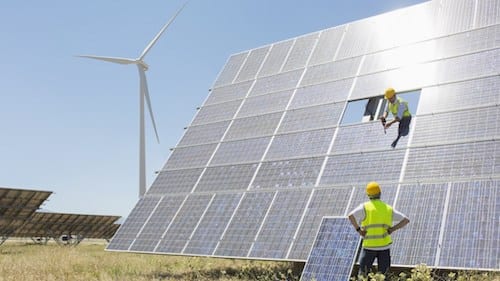
A new study finds that wind power and solar photovoltaics could by themselves meet 80 percent of all U.S. electricity demand.
“Five years ago, many people doubted that these resources could account for more than 20 or 30 percent,” co-author Steven Davis of the University of California at Irvine (UCI) explained in a news release. So, “the fact that we could get 80 percent of our power from wind and solar alone is really encouraging.”
It’s especially encouraging for two additional reasons. First, the price of solar and wind have been dropping rapidly.
This chart from Reuters last week shows that power from wind and solar are already the cheapest sources of power.

Second, the study only examined how wind and solar could power the grid. In doing so, it found these two sources alone could provide 80 percent of the power. This still leaves 20 percent that could be provided by a variety of alternative types of carbon-free power.
And in terms of alternate carbon-free power sources, hydropower already provides 6.5 percent of U.S. power while geothermal and biomass together add another 2 percent. All of those can be expanded.
In addition, while most current nuclear plants are bleeding cash (and so new nuclear power doesn’t make much economic sense), even a modest carbon price would at least keep most existing plants competitive enough to support any transition to high renewable penetration.
Nuclear currently provides nearly 20 percent — one fifth — of U.S. power.
For this latest study, scientists at the Carnegie Institution for Science, UCI, and CalTech looked at 36 years of hourly U.S. weather data “to understand the fundamental geophysical barriers to supplying electricity with only solar and wind energy.”
The key to achieving 80 percent penetration of just solar and wind power is “a continental-scale transmission network or facilities that could store 12 hours’ worth of the nation’s electricity demand.”
Fortunately, costs for battery storage have plummeted in recent years so fast that in Colorado, building new renewable power plus battery storage is now cheaper than running old coal plants.
This latest finding should help resolve the debate as to whether the United States can have an affordable carbon-free grid by mid-century. We absolutely can.
Indeed, just two years ago, a 2016 paper led by NOAA researchers found “the United States could slash greenhouse gas emissions from power production by up to 78 percent below 1990 levels within 15 years while meeting increased demand.” And that could all be done “with commercially available technology” and “at costs similar to today’s.”
In fact, Energy Secretary Rick Perry’s own grid study from 2016 makes clear the solution to enabling very deep renewable energy penetration is at hand: The future is smart control systems and electric cars.
While more research is needed to understand the optimum strategy for the renewable energy transition, the most important takeaway from this study is that we should keep accelerating the deployment of all types of renewables and storage.
Source: ThinkProgress. Reproduced with permission.










